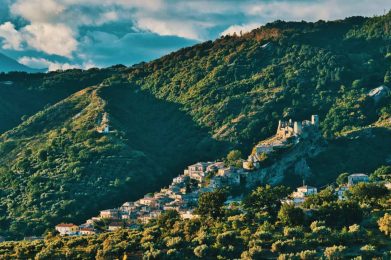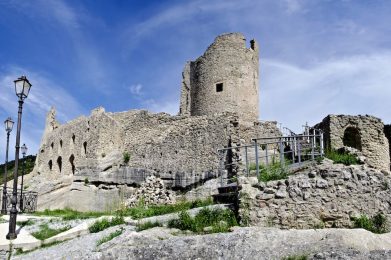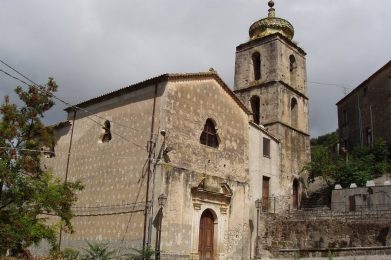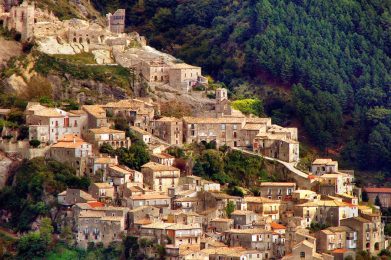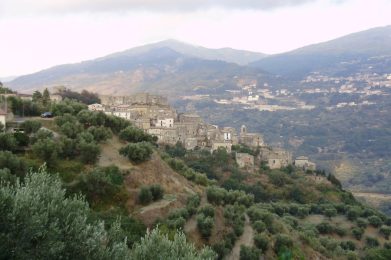Cleto is a place that goes beyond time: rooted in legend, enriched by historical layers, and projected into the future through cultural enhancement and conscious tourism. To visit Cleto is to take a journey into the authentic heart of Calabria, among memory, landscapes and wonder.
Immagini del borgo
Nestled on the slopes of Mount Sant’Angelo, overlooking the Savuto Valley to the sea, the village of Cleto, in the province of Cosenza, is a treasure chest of memory, beauty and identity. With just over 1,200 inhabitants, it is a place to be discovered slowly, where every stone tells ancient stories and every glimpse offers timeless suggestions.
Origins between myth and history
Legend has it that Cleto was founded by Cleta, nurse of the Amazon queen Pentasilea, who fell during the Trojan War. Pushing out to sea to give her a proper burial, Cleta settled in a place that had impressed her with its beauty, founding a town named after her. History, however, places the origins of the village in the Magna Graecia period, as a colony of the polis of Crotone. It was precisely this connection that caused its destruction in 16 B.C. by the Crotonese army, after a request for independence from the city.
For about a millennium Cleto lay dormant, until its rebirth under the Normans, who changed its name to Pietramala. This evocative toponym-“inaccessible stone”-well describes the impervious and strategic location of the village, which in time became an important fiefdom linked to the powerful Florense Abbey of Fontelaurato.
An eventful past
From the 13th century onward, Cleto experienced a long sequence of dominations and feudal transitions: from the Angevins to the Aragonese, from the Sersale to the Siscar to the Giannuzzi-Savelli, who ruled the barony until the abolition of feudalism. Amidst Turkish plunder, earthquakes, plague and Risorgimento uprisings, Cleto managed to survive, keeping its soul and identity alive. In 1863, in homage to its mythical roots, the village regained its original name.
What to see
Cleto is an open-air museum, ideal for those who like to get lost among narrow streets, stone arches and panoramic views. Among its treasures: The Norman Castle, symbol of the village, recently restored and open to the public. Located on the top of the hill, it allows visitors to explore towers, interiors and walkways with breathtaking views down to the sea; The Church of Santa Maria Assunta (16th cent.), with three naves, handcrafted stucco and local stone; The seventeenth-century Church of the Consolation, with a majolica-tiled Byzantine bell tower and a floor depicting the flower of life. The Church of the SS. Rosario, another important place of worship in the hamlet; The Cece Fountain, in the Pantano locality: an archaeological area that preserves a 14th-century B.C.E. cave tomb and artifacts dating back to the Eneolithic period; The Ruins of Savuto Castle, in the hamlet of the same name, a medieval testimony immersed in nature.
Traditions and flavors
The village has a strong agricultural tradition, particularly in the cultivation of olive trees, from which an excellent extra virgin olive oil is made. Among the typical products is the Cialetta, a fragrant semolina bread, perfect to enjoy with local olive oil and the flavors of Calabrian cuisine.
The Cleto Festival
A must-see event, the Cleto Festival is a cultural event that has enlivened the village’s summer for years with concerts, theater, art installations and workshops. An opportunity to experience Cleto in a contemporary light, between creativity and tradition.
Village of Cleto
Municipality of Cleto
Province of Cosenza
Calabria Region
Population: 1.275 cletesi
Altitude centre: 250 m s.l.m.
Municipality
Via Palmenta 2 – Tel. +39 0982 44051
BY CAR
- Along the highway, the closest exits to the center of Cleto are:
– S.Mango d’Aquino exit (A2 Salerno-Reggio Calabria)
– Exit Altilia – Grimaldi (A2 Salerno-Reggio Calabria)
ON THE TRAIN
- Lamezia Terme station
- Cosenza railway station
BY PLANE
- Lamezia Terme airport
- August – Cleto Festival. Three evenings of music, art and meetings, linked by a conductor wire, in a village of ancient charm.

